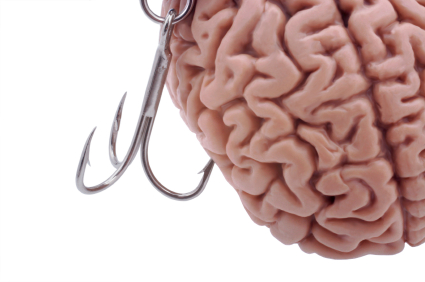Penalty Pain: How to Make Your Customers Hate You

Neuromarketing readers are by now familiar with the idea of “buying pain” or “pain of paying” – when we buy something, the pain center in our brain can be activated. Work by Carnegie Mellon’s George Loewenstein and others shows that this effect is greatest when the price is perceived to be high or unfair. Buying a pack of gum for $10 would be a lot more “painful” than spending 50 cents for the same item. One wonders how painful paying multiple $40 bounced check fees would be, particularly if you knew your bank processed the largest checks first to ensure the maximum number of bounces.
Frank Capek at the Customer Innovations blog wrote an interesting piece, Cognitive Ergonomics: How Customers React to Violations of Justice. Referring back to a Harvard Business Review article by Gail McGovern and Youngme Moon, Companies and the Customers Who Hate Them, Capek lists some of the ways companies profit by penalizing customers:
– Video rental stores that generate a significant portion of their profits from late fees
– Credit card companies that approve rather than decline over limit transactions and then charge the customer fees
– Banks that present checks in reverse order of magnitude to increase the likelihood that more checks will be drawn against insufficient funds
– Cellular providers that lock customers into lengthy contracts rather than creating loyalty through good service.
Capek goes on to tie this behavior into how neuroeconomics currently understands the concept of justice and fairness, noting that experiments like the Ultimatum Game demonstrate that a desire for fairness can override even self-interest. It’s a thoughtful analysis and worth a read.
I don’t think that every penalty will engender a pain reaction. I often pay a small library fine to keep a book I haven’t quite finished for a few more days. While I haven’t climbed into an fMRI machine while I pay these fines, I’m reasonably sure there’s not much pain involved. The amount is low both in absolute terms and in relation to the value of the product, and the decision to keep the book beyond the deadline was mine. That seems fair in every way.
Luckily, I haven’t bounced any checks lately, but I can imagine that as being a far more painful experience. The reason for the bouncing may be perceived, rightly or wrongly, as the bank’s fault to begin with (e.g., checks have been deposited to the account but haven’t been credited, resulting in the consumer thinking his balance is higher.) Second, bank procedures like cashing high-value checks first can increase the number of checks that fail to clear in a particular incident – thus, several small $10 checks that would have cleared with no problem may end up bouncing too. The penalty pain really kicks in when the consumer must pay a hefty fee to the bank for each item, and probably another fee to the store where they wrote the check. State laws allow returned check fees as high as $40, meaning that the fees for each check can greatly exceed the amount of the original transaction. Even ignoring the hassles the consumer will go through to straighten everything out and the embarrassment involved, that’s definitely a setup for penalty pain.
Businesses should weigh the short-term boost in profits from penalizing otherwise good customers against the pain these penalties will cause and the damage to their brand in the minds of those customers. I have no doubt that these profits can be seductive. Imagine a bank’s IT guy modeling the revenue under different processing scenarios, and showing that a trivial change in the processing order could result in millions in incremental revenue by year-end. Or that processing them in a way that benefits the customer would cost millions. Besides, these aren’t really “good” customers, right? They are bouncing checks, so why not sock it to ’em?
That logic may be seductive, but it’s a slippery slope; soon, it’s not just the customers that you would be happy to lose who are penalized, but customers who are still valuable to the firm. And changing policies in a way that would cut revenue can be incredibly difficult. It’s far easier to keep rationalizing the practices as acceptable, and even increasing penalties when other revenue streams are weak.
If your business is profiting from penalizing your customers, you should take a serious look at how it is perceived. Is it affecting a tiny percentage of problem customers, or a big portion of your base? Do customers perceive the penalties as fair? Are you taking steps to help customers avoid penalties, or do you place them like hidden land mines in the customer experience? I don’t doubt that every business has some justified penalties to discourage problematic behavior by customers (e.g., not paying their bills), but it’s bad branding and customer retention strategy to cause a large number of customers penalty pain.
